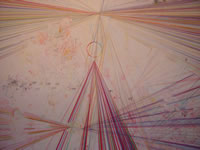What is it about paper?
 (above, Michelle Oosterbahn, detail of AH-HA, courtesy of Gallery Joe)
(above, Michelle Oosterbahn, detail of AH-HA, courtesy of Gallery Joe)
What is it about paper? For centuries, it’s been a repository for humanity’s dreams, secrets, visions and mundane routines. Our picture of 17th century England gains color due to Samuel Pepys’s journaling; and through James Castle’s ghostly drawings we may enter, ever so slightly, into a recluse’s world. When our minds were full to the bursting, paper was there to be the tabula rasa that we could not. Humans can also identify with paper’s tenuous hold on existence. Like us, paper can be destroyed in a few minutes, but if properly cared for, can last a century or more. Indeed, like us, paper often strives for permanency within its ephemerality – especially when an artist takes the material seriously, and wrings it of all possibility.
In the latest version of Arcadia University’s lauded Works on Paper exhibits, I noticed three apparent dualities that relate closely to human experience, and are seen especially in art on paper: ephemeral, yet striving for permanence; intimate, yet ultimately distant and mysterious; and immediate, yet complex. In these three ways, we may understand partly why humans keep returning to paper, and why it seems to have seduced us as a material.
Michelle Oosterbahn’s drawing AH-HA – done in a style reminiscent of Matthew Ritchie or Julie Mehretu, who was recently featured in the Fabric Workshop’s Swarm – creates a complex, belabored environment, attempting to assert its own or the artist’s permanence through meaningful repetition. And the piece scintillates in a subdued, colored-pencil manner; asking if, indeed, some permanence can be created, is it not through committed persistence?
This repetitive action towards permanence is set into effective relief by Gabriel Martinez’s Blackbird Confetti. Martinez has piled, thousand fold, tiny cutouts of blackbirds on the gallery floor. It’s as if, suddenly failing in their migration, the birds have fallen, en masse, to a mysterious demise. These paper birds could quickly be reduced to a devastated mush – in fact, a point is made of the paper being biodegradable – and yet in their insistent repetition, self-assertiveness has been established, which contributes, if not to longer life, to a certain valor in whatever end this avian group has met.
Several of the pieces in the exhibit read like diaries; undeniably intimate – both through subject and execution – yet absolutely mysterious. There is a perceptual wall that can be seen through only, as a glass, darkly. The individual artist chooses how universal to make their revelations and pronouncements – and it seems that paper fosters mystery, encouraged by its intimacy. That is, because of the subjective nature of the works, their extreme universality – for example, we all had a childhood – bursts through into a profound mysterious state. Which is, of course, necessary to attract us: reading your own diary isn’t nearly as enthralling as reading someone else’s.
Human beings are so often two different creatures: consider first versus second impressions. This idea is also expressed by traumatized family members or neighbors stating on TV “…he was such a nice, quiet man…” This immediacy or simplicity, contrasted with underlying complexity, is evidenced in both Nils Orth’s montaged photographs – in a physical manner – of three teenaged faces, and in a more metaphysical way in Jessica Doyle’s untitled mixed media drawing of a weird park or reunion scene. Both works are immediately recognizable and seem scrutable – until a lingering look tells us something’s awry. There’s a certain neo-surreality to both of these works. Nils Orth, through digital manipulation of various faces into one, has created portraits both Everyman and weirdly alien; they are strange in their non-specificity. A simple portrait has become a complex digitally altered question of reality and veracity. Jessica Doyle’s drawing also seems fairly familiar; the subject and the medium and even setting seem workaday. But upon considering the encroaching sunset, the concerned and self-absorbed stares on the figures’ faces, the drawing turns towards a macabre ennui. This is not a reunion; this is a group of individuals who may themselves be asking, what am I doing here? Why am I with these other people? There is a definite sense of existential doubt…as if drawn from a highly subjective memory of an old picnic snapshot – but the memory has stuck in the artist’s craw, and inky dread has seeped to the surface.
Perhaps one reason we keep turning back to paper, is because like an unavoidable mirror, we continue to see ourselves – our condition – in this equally natural and manmade material; and we must respond.




